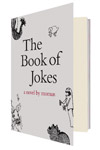A few months ago, the editors of this magazine asked if I would be interested in being part of an experiment in criticism. They were curious what would happen if we inverted the standard “anonymous review” formula—if instead of the reviewer having the cloak of anonymity, we were to keep the book under review anonymous from its critic, and thereby shield it from any and all prejudice—whether positive or negative, whether directed at the author, the publishing house, the blurbers, the cover art, etc. I swore several oaths to stay true to the project (Eds.: “No googling”), and soon enough a book arrived at my house. Its covers, front matter, and endpages had all been stripped, and the spine blacked out with a Sharpie. I didn’t know what it was called or who wrote it or who was publishing it or when. I didn’t know if it was the author’s first or twenty-first publication. Fiction? Nonfiction? Genre? Self-published? I didn’t know anything (and at this writing, I still don’t) except that it wasn’t poetry. What could I do? I began to read.
Dad darkens my sister’s doorway, throws his shadow across the fine-haired skin of her white belly. The lamplighters crane to watch. They will report what they’ve seen to the postmen, and the postmen will report it to the teachers, and the teachers—solemnly—to their classes. Then the school bullies will corner me in a piss-stinky lavatory cubicle and tell me.
But I’ll know already. Because of the taste on Dad’s dick.
So, uh, not nonfiction then? (Please, please, please don’t let this be nonfiction.)
Soon after, the speaker finds himself in that very lavatory, getting bullied just as predicted. “Do you want to die peacefully in your sleep like your grandpa,” the bullies ask him, “or screaming in terror like his passengers?”
Now wait a minute. I reread the sentence to be sure. Was it? Oh yeah. That’s a joke! A joke I’d heard before! Realizing this made me realize that the line about Dad’s dick in the first scene was, in fact, a punch line. The whole scene was a retelling of an old, gross—but hardly unfunny—joke. I read on, and the jokes kept coming.
The book follows two main characters, the priapic Sebastian Skeleton and his perpetually beset son Peter, who switch off chapters as narrator. They—along with Peter’s...
You have reached your article limit
Sign up for a digital subscription and continue reading all new issues, plus our entire archives, for just $1.50/month.
Already a subscriber? Sign in





